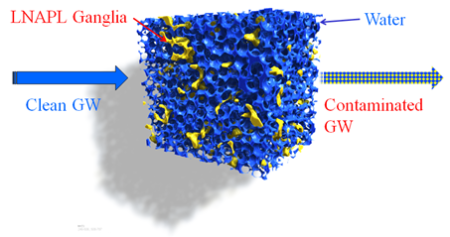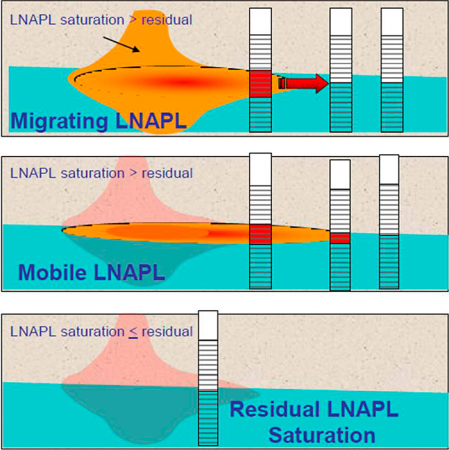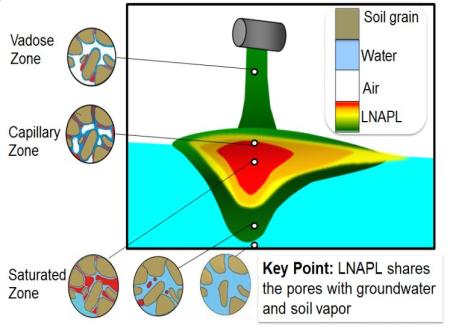Light Non Aqueous Phase Liquids (Free Product)
LNAPL (light non-aqueous phase liquid) is an immiscible organic liquid that is less dense than water. Initially, all petroleum releases originate as LNAPL in the form of gasoline, diesel fuel, lube oils or other petroleum products.
LNAPL may represent the greatest mass of contamination in the subsurface from a petroleum release and may also be a source of petroleum vapors to intrude into structures, and an ongoing source of dissolved phase groundwater contaminant plumes. Therefore, it is critical to accurately characterize the spatial distribution of LNAPL to enable LNAPL abatement, remediation, and risk management to protect human health and the environment.
The complex distribution of LNAPL in the subsurface makes assessment and remediation challenging. Recent advances in LNAPL science have improved the understanding of LNAPL behavior in the subsurface. The purpose of this guidance is to apply this improved understanding of LNAPL behavior to adequately characterize LNAPL distribution and identify site-specific LNAPL concerns.
- LNAPL Saturation
LNAPL never occupies 100% of pore spaces; instead it shares the pore spaces with air in the unsaturated zone and water in the saturated zone. Even then, LNAPL does not continuously occupy the pore spaces. The image below depicts LNAPL ganglia sharing pore spaces with water in the absence of soil
Image from Singh et al. (2011)
Basic LNAPL concepts and terminology are introduced in the ITRC LNAPL-3 technical guidance document.
Of particular importance to understand is the difference between residual, mobile, and migrating LNAPL. The figure below illustrates these three LNAPL saturation conditions.
- Distribution Model
LNAPL does not simply float on top of the water table. Rather, LNAPL is distributed above, at, and below the water table at saturations that vary vertically and horizontally. The image below is a simplified depiction of LNAPL distribution.
- In-Well LNAPL Thickness
The amount of LNAPL in a well is a poor indicator of the vertical and lateral extent of LNAPL, LNAPL volume and recoverability. Measured LNAPL in a well is a clear indicator that mobile and potentially migrating LNAPL is present.
- LNAPL Migration/Stability Evaluation
LNAPL migration is controlled by the driving head of the LNAPL and the ability of the LNAPL to overcome pore entry pressure. For a finite release, LNAPL ceases to migrate within a relatively short period of time depending on the magnitude of the release. This is because, among other reasons, the LNAPL gradient dissipates over distance and time and thus the driving head decreases.
- Recoverability
Mobile and migrating LNAPL saturations may be recoverable, but residual concentrations are not readily recoverable. Residual range saturations may still need to be considered and addressed, as they could be a continuing source of dissolved and vapor phase impacts.
The components of an LCSM (LNAPL Conceptual Site Model) are the same as those identified in the CSM section of guidance. However, additional considerations should be made when developing a CSM where LNAPL is present or believed to be present.
ASTM Standard Guide 2531 provides further detail on developing a CSM for LNAPL sites.
LNAPL Indicators
LNAPL observed in a monitoring well
LNAPL observed in a monitoring well is a direct indicator that LNAPL is present and mobile or potentially migrating.
Dissolved-phase analytical data
Dissolved-phase analytical data may be utilized as an indirect indicator that LNAPL is present. Persistent dissolved-phase analytical data that shows little degradation or change in concentration over time may be an indicator that LNAPL is present in the subsurface. Additionally, dissolved-phase concentrations near the effective solubility of a particular chemical of concern may be an indicator. For example, the effective solubility of benzene is typically stated to range between 9-18 mg/L for unweathered gasoline. Generally, dissolved-phase concentrations of benzene above 1 mg/L may indicate that there is an LNAPL source, depending on the amount of weathering that has occurred and the location of the monitoring point relative to the LNAPL source.
Conventional Soil Assessment Information
Conventional soil data may be utilized as an indirect indicator of LNAPL presence. For this reason, it is important to have continuous core samples, complete boring logs and detailed cross-sectional diagrams. It is not recommended by OPS to collect environmental soil data at predetermined intervals.
In general, high TPH concentrations in soil may be indicative of LNAPL.
High PID readings, or readings that change abruptly, may also be an indirect indicator of LNAPL.
Field sheen tests (i.e., shake tests, jar tests) may be used to evaluate the presence of residual LNAPL. Soil samples containing LNAPL can create a hydrocarbon sheen on the water if agitated.
Laser-Induced Fluorescence
LIF (laser-induced fluorescence) can be used as a downhole tool to qualify the distribution of LNAPL in the subsurface. Modeling software can create a 3-dimensional representation of LNAPL, as shown below.
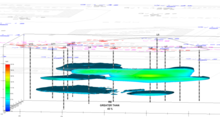
Conceptual Challenges
Understanding and identifying the conceptual challenges presented below are important for understanding LNAPL migration pathways, developing the LCSM and, ultimately, developing an effective LNAPL remedial strategy.
Residual Saturation
It is important to know the distribution of residual LNAPL because it may be a persistent source for groundwater and vapor impacts. Failure to identify residual LNAPL will result in an inaccurate LCSM and delayed progress with cleanup.
Water Table Fluctuations
Water table fluctuations can cause LNAPL to become trapped below the water table. LNAPL trapped below the water table may become mobile and enter monitoring wells with a drop in the water table in unconfined conditions. Water table fluctuations may give the impression that LNAPL is appearing and disappearing as shown in this Video Clip.
Geologic Structure, Lithology and Transport
LNAPL distribution and appearance in monitoring wells will differ based on unconfined versus confined conditions, perched lenses and fractured pathways. A gross understanding of the geologic stratigraphy is essential. However, LNAPL transport is often controlled by microscopic characteristics of the soils, so details such as grain size, sorting, veining/fractures and microbedding should be noted.
Questions to ask when LNAPL is present in a monitoring well
- Is the source of this LNAPL known?
- Is the route of transport understood?
- Is the vertical and horizontal distribution of LNAPL understood?
- Is the location of the monitoring well in the right place to answer these questions?
- Does the LCSM need to be updated?
- Is the LNAPL recoverable?
Utilization of High-Resolution Site Characterization
OPS recommends the utilization of high-resolution site characterization to enhance the LCSM when appropriate. These tools assist in understanding the distribution and magnitude of the LNAPL in the subsurface and ultimately may be used to identify the concerns and remedial objectives associated with LNAPL.
LNAPL transmissivity (Tn) is an indicator of the ability of a formation to transmit LNAPL. Tn values are used to assess LNAPL migration and recoverability and are obtained from LNAPL recovery/recharge tests and analysis. Tn values can vary spatially and temporally at a release site.
OPS recommends consideration of Tn bail down testing when in-well LNAPL thickness is > six inches. The number of tests and the number of locations are dependent on the spatial and temporal understanding of LNAPL distribution. Generally, tests should be completed during a period of low groundwater elevation.
Tn tests should be conducted per ASTM Standard Guide 2856. An instructional video for conducting an LNAPL bail down test can be viewed at the following link (courtesy of the American Petroleum Institute).
ITRC has proposed that LNAPL recovery is practical when Tn is above the range of 0.1 to 0.8 ft2/day.
The following guides, workbooks and articles provide additional information on LNAPL transmissivity:
LNAPL concerns are either saturation-based or composition-based as illustrated in the figure.
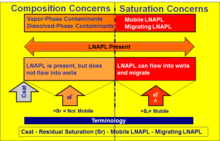
Saturation-based concerns mean that the LNAPL saturation is greater than residual saturation. The primary saturation-based concern is the potential for LNAPL migration. Recoverability should be evaluated by LNAPL transmissivity testing.
Composition-based concerns include dissolved-phase and vapor-phase exposure. Residual LNAPL saturation may need to be reduced to abate these concerns.
Based on our improved understanding of LNAPL distribution, characteristics and concerns, OPS has developed the following policies:
OPS has adopted a range of Tn < 0.1 to 0.8 ft2/day, with consideration given to spatial and temporal understanding. LNAPL saturation objectives should be addressed until Tn values are below the range.
When recovery is negligible, focus on compositional concern to achieve closure.
Release Events can be closed with measurable LNAPL if there are no compositional concerns and the LNAPL recovery is negligible.
